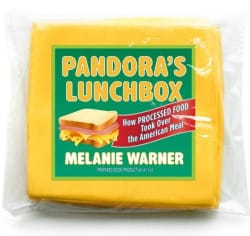Pandora’s Lunchbox, by former New York Times business reporter Melanie Warner, offers a fascinating behind-the-scenes look at the processed foods industry.
– Charlotte Vallaeys, Director, Farm and Food Policy
 By exploring exactly how the edible concoctions sold to us as “food” are made, the book sheds light on why we would all be better off eating real food, grown in soil and raised on farms, rather than the creations of food chemists in lab coats that are assembled in factories rather than cooked in kitchens.
By exploring exactly how the edible concoctions sold to us as “food” are made, the book sheds light on why we would all be better off eating real food, grown in soil and raised on farms, rather than the creations of food chemists in lab coats that are assembled in factories rather than cooked in kitchens.
As I read Pandora’s Lunchbox, I thought often of an assertion made by Sir Albert Howard, one of the organic movement’s founding fathers: solutions to agricultural problems must come from the field, not the factory. Howard was talking about soil fertility—rich and healthy soil is the result of careful and conscious farming practices that value and respect natural processes, rather than of the application of synthetic fertilizers produced in a factory from the same starting materials used to create explosives. I was reminded of Howard’s observation often while reading Warner’s book. Whereas Howard applied this principle to farm fields, Warner applies it to food processing.
If you are reading this book review and are a Cornucopia member, chances are that you already make an effort to avoid conventional processed foods. But many of the lessons from Warner’s book apply to organic processed foods as well (after all, aren’t we all at times too busy or tired to cook from scratch, and reach for that certified organic frozen pizza or TV dinner?).
One example is her eye-opening discussion of synthetic vitamins. As Warner aptly points out (and Cornucopia has been working to address for years), synthetic vitamins have a carte blanche approval in organics. Many organic consumers assume that the added vitamins in organic foods are “organic,” but they are no different from the synthetic vitamins added to conventional foods. Vitamin D in organic milk likely came out of a Chinese factory that transformed Australian wool grease into this added nutrient. Factories that produce vitamin C emit numerous hazardous air pollutants; the last operating vitamin C plant in the United States closed in 2005 and the void has been filled by Chinese companies. Half a dozen Chinese companies now produce 90% of the vitamin C—and yes, this is the same vitamin C that often appears as an added ingredient in organic foods.
At times while reading the book, I found myself wanting to hear more of Warner’s personal experiences and thoughts. Her reflections finally came at the end of the book, and were worth the wait. She writes about a family in California that made the switch from a diet of processed foods to real foods, and how it changed their lives. Not only did it drastically improve one of their children’s behavioral problems—the reason they made the switch—it also improved the health (and weight) of the other members of the family. I also appreciated that Warner addresses questions such as cost and convenience—it bears repeating that fast food meals generally cost more than simple, healthy home-cooked meals, even with all organic ingredients.
A couple of years ago, Michael Pollan opened many people’s eyes to the basic fact that we should “eat food.” By digging into the depths of the processed foods industry and sharing the ins and outs, Warner’s Pandora’s Lunchbox is essentially a 200-page justification of why we should “eat food,” rather than edible food-like substances coming out of the laboratories and factories that the book tells us all about.

